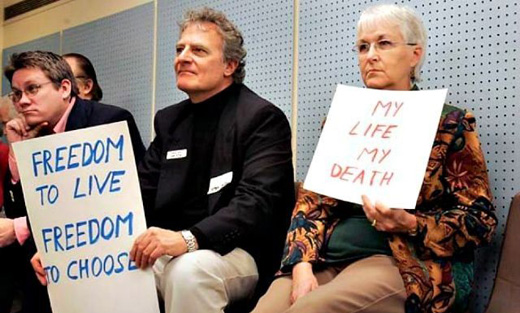
After two decades of struggle by its advocates, and months of dramatic debate in the current legislative session, California Governor Jerry Brown on Oct. 5 signed into law the End of Life Options Act. California will now join Oregon, Washington, Vermont, and Montana in allowing physicians to prescribe lethal medications to terminally ill patients.
The bill, authored by Assemblywoman Susan Talamantes Eggman, D-Stockton, requires that terminally ill, competent adults opting to receive the drugs must be capable of making medical decisions, must voluntarily ask for and self-administer the drug. They must be diagnosed as terminal by two independent doctors, and must make two oral requests at least 15 days apart. They must also make a written request that has been witnessed, and sign a paper 48 hours before taking the drugs. Hospitals and physicians may refuse to offer the medications.
Despite opposition by the Catholic Church and other religious groups, disability rights organizations, Latino organizations, right-to-life and some medical groups, a Field Poll released Oct. 5 showed 65 percent of registered voters surveyed backed the measure, including 55 percent of Catholics and 58 percent of Protestants, 55 percent of Republicans, and 56 percent of Latinos. Democrats and nonpartisan voters each backed the bill by 70 percent.
While the American Medical Association continues to oppose physician-aided death, the California Medical Association earlier this year shifted to a neutral stance.
Despite the failure of all earlier efforts, this time the experience of 29-year-old Californian Brittany Maynard, terminally ill with brain cancer, who moved with her family to Oregon because that state allows doctors to prescribe life-ending drugs, gave dramatic impetus to the debate. Maynard died last November; her family testified in support of this year’s bill.
The measure still had a rugged path in the legislature, stalling in committee during the regular session before being revived in a special session on health care. It is to take effect late next year, after the special session ends.
Brown, a former Jesuit seminarian, accompanied his signature with a searching and personal statement. He said he had carefully considered the “thoughtful opposition materials” by doctors, religious leaders and disability rights advocates, as well as the supporting views of Maynard’s family and South African retired Anglican Archbishop Desmond Tutu.
“In addition,” he said, “I have discussed this matter with a Catholic bishop, two of my own doctors and former classmates and friends who take varied, contradictory and nuanced positions.”
In the end, Brown said he did not know what he would do if he were dying in prolonged, excruciating pain. But, he said, he is certain it would be a comfort to be able to consider the options in the bill, and he “wouldn’t deny that right to others.”
Speaking Oct. 6 on PBS radio station KQED’s Forum program, Marilyn Golden, senior policy analyst with the Disability Rights Education and Defense Fund, called the law “a recipe for elder abuse and abuse of people with disabilities.” She said someone who stands to inherit from the patient, or an abusive caregiver, could steer a patient toward the procedure despite the safeguards built into the measure.
David Magnus, director of Stanford University’s Center for Biomedical Ethics, pointed out that in Oregon, where the law has been in effect since 1997, only around 100 people a year actually use its provisions, far fewer than those who refuse unwanted treatment or voluntarily refuse water and food. Magnus called the legal provisions, and the debate around them, “symptoms of a problem rather than the solution to it,” and urged more attention to the “much deeper problem about how we deal with communication and care at the end of life.”
Toni Broaddus, California campaign director for Compassion and Choices, which advocates for end-of-life options including doctor-aided death, said she sees the new law as having a positive effect on improving end-of-life care including opening the space for doctors and patients “to talk about all the options at the end of life, because everyone needs something different.”
Photo: People show support for the End of Life Options Act. | Blogspot










